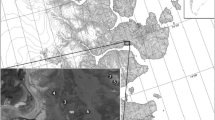Abstract
The objective of this study was to ascertain whether the impact of lizards on spiders varies temporally, and if so, whether this variability is related to rainfall. We compared annual censuses of orb-spider populations on 24 islands with diurnal lizards present, and on 20 islands with diurnal lizards absent, to rainfall over a 10-year period. A strong positive correlation (Pearson r=0.877) was found between mean spider density on nolizard islands and the number of days of rain that occurred 2 months prior to spider censuses; correlation coefficients declined with longer and shorter time periods prior to censuses. Correlation coefficients between mean spider density on lizard islands and rainfall showed a similar pattern but were generally lower than those for no-lizard islands. The strength of the impact of lizards on spiders, measured as the ratio of mean spider density on no-lizard islands to mean spider density on lizard islands, varied considerably and was positively correlated with rainfall; the correlation was highest with number of rain days 6 months prior to spider censuses (r=0.741). Repeated-measures analysis of variance on the time series of spider densities showed that the lizard factor (present versus absent) varied significantly among years. Split-plot ANOVA with rainfall as a covariate indicated that spider density and the impact of lizards on spider density were both significantly correlated with rainfall. We discuss several hypotheses on the causal mechanisms that integrate abiotic and biotic factors.
Similar content being viewed by others
References
Connell JH (1975) Some mechanisms producing structure in natural communities: a model and evidence from field experiments. In: Cody ML, Diamond JM (eds) Ecology and evolution of communities. Belknap, Cambridge, Mass, pp 460–490
Connell JH (1983) On the prevalence and relative importance of interspecific competition: evidence from field experiments. Am Nat 122:661–696
Dunham AE (1980) An experimental study of interspecific competition between the iguanid lizards Sceloporus merriami and Urosaurus orantus. Ecol Monogr 50:309–330
Dunson WA, Travis J (1991) The role of abiotic factors in community organization. Am Nat 138:1067–1091
Heske EJ, Brown JH, Mistrys S (1994) Long-term experimental study of a Chihuahuan Desert rodent community: 13 years of competition. Ecology 75:438–445
Holt RD (1977) Predation, apparent competition, and the structure of prey communities. Theor Popul Biol 12:197–229
Hunter MD, Price PW (1992) Playing chutes and ladders: heterogeneity and the relative roles of bottom-up and top-down forces in natural communities. Ecology 73:724–732
Hurlbert SH, White WD (1993) Experiments with freshwater invertebrate zooplanktivores: quality of statistical analyses. Bull Mar Sci 53:128–153
Kingsolver JG (1989) Weather and population dynamics of insects: integrating physiological and population ecology. Physiol Zool 62:314–334
Kareiva PM, Kingsolver JG, Huey RB (1993) Biotic interactions and global change. Sinauer, Sunderland, Mass
Littell RC, Freund RJ, Spector PC (1991) SAS system for linear models. SAS Institute Inc., Cary, NC
McArdle BH, Gaston KJ, Lawton JH (1990) Variation in the size of animal populations: patterns, problems and artifacts. J Anim Ecol 59:439–454
Menge BA, Sutherland JP (1976) Species diversity gradients: synthesis of the roles of predation, competition and temporal heterogeneity. Am Nat 110:351–369
Menge BA, Berlow EL, Blanchette CA, Navarrete SA, Yamada SB (1994) The keystone species concept: variation in interaction strength in a rocky intertidal habitat. Ecol Monogr 64:249–286
Murdoch WW, Oaten A (1975) Predation and population stability. Adv Ecol Res 9:1–131
Neter J, Wasserman W, Kutner MH (1985) Applied linear statistical models. Richard D Irwin Inc., Homewood, Ill
Peterson CH, Black R (1988) Density-dependent mortality caused by physical stress interacting with biotic history. Am Nat 131:257–270
Pimm SL (1991) The balance of nature? University of Chicago Press, Chicago, Ill
Rice WR (1989) Analyzing tables of statistical tests. Evolution 43:223–225
Schoener TW (1982) The controversy over interspecific competition. Am Sci 70:586–595
Schoener TW (1983) Field experiments on interspecific competition. Am Nat 122:240–285
Schoener TW (1986) Patterns in terrestrial vertebrate versus arthropod communities: do systematic differences in regularity exist? In: Diamond J, Case TJ (eds) Community ecology. Harper and Row, New York, pp 556–586
Schoener TW, Spiller DA (1987) High population persistence in a system with high turnover. Nature 330:474–477
Schoener TW, Spiller DA (1992) Is extinction rate related to temporal variability in population size? An empirical answer for orb spiders. Am Nat 139:1176–1207
Schoener TW, Toft CA (1983) Spider populations: extraordinarily high densities on islands without top predators. Science 219:1353–1355
Shumway RH (1988) Applied statistical time series analysis. Prentice Hall, Englewood Cliffs, NJ
Sokal RR, Rohlf FJ (1981) Biometry, 2nd edn. Freeman, San Francisco
Sousa WP (1979) Disturbance in marine intertidal boulder fields: the non-equilibrium maintenance of species diversity. Ecology 60:1225–1239
Spiller DA (1992) Numerical response to prey abundance by Zygiella x-notata (Araneae, Araneidae). J Arachnol 20:179–188
Spiller DA, Schoener TW (1988) An experimental study of the effect of lizards on web-spider communities. Ecol Monogr 58:57–77
Spiller DA, Schoener TW (1990) Lizards reduce food consumption by spiders: mechanisms and consequences. Oecologia 83:150–161
Spiller DA, Schoener TW (1994) Effects of top and intermediate predators in a terrestrial food web. Ecology 75:182–196
Spiller DA, Schoener TW (1995) Food-web dynamics on some small subtropical islands: effects of top and intermediate predators. In: Polis GA, Winemiller C (eds) Food webs: integration of pattern and dynamics. Chapman and Hall, London
Stamps J, Tanaka S (1981) The influence of food and water on growth rates in a tropical lizard (Anolis aeneus). Ecology 62:33–40
Stevens J (1992) Applied multivariate statistics for the social sciences, 2nd edn. Lawrence Erlbaum Associates, Hillsdale, NJ
Toft CA, Schoener TW (1983) Abundance and diversity of orb spiders on 106 Bahamian islands: biogeography at an intermediate trophic level. Oikos 41:411–426
Wiens JA (1977) On competition and variable environments. Am Sci 65:590–597
Winer BJ (1971) Statistical principles in experimental design. McGraw-Hill Book Company, New York
Wise DH (1993) Spiders in ecological webs. Cambridge University Press, Cambridge, UK
Author information
Authors and Affiliations
Rights and permissions
About this article
Cite this article
Spiller, D.A., Schoener, T.W. Long-term variation in the effect of lizards on spider density is linked to rainfall. Oecologia 103, 133–139 (1995). https://doi.org/10.1007/BF00329072
Received:
Accepted:
Issue Date:
DOI: https://doi.org/10.1007/BF00329072




